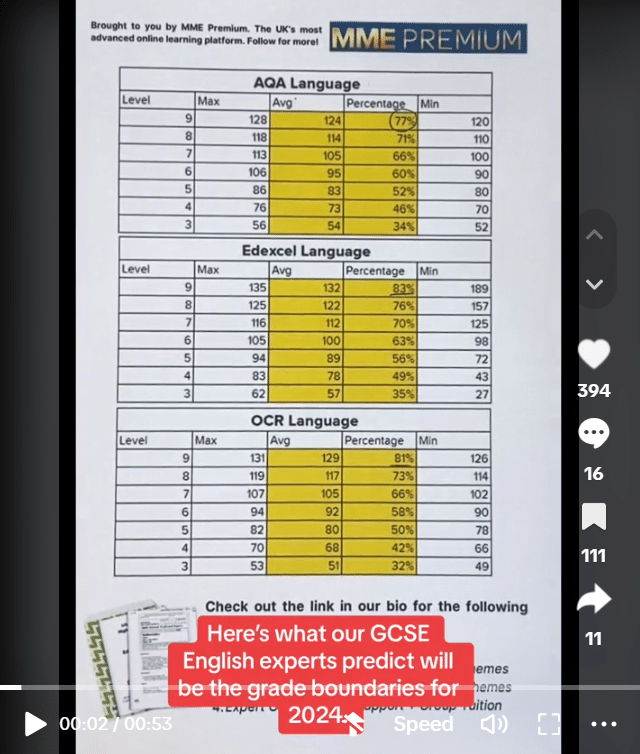Reading: Meaning in Language
Reading: Meaning in Language Revision
Reading Fiction: Meaning in Language
Texts can be complicated, especially ones you’ve never read before.
So, it can help to learn how to read them in greater depth, allowing you to find the underlying meaning within a text, and therefore answer the exam questions more effectively.
Tone

Tone can be difficult to pick up on at first, as it is something that is not directly stated in the text.
Instead, the overall tone of a text is something that you have to infer from what is written.
Once you know how to pick up on it though, tone isn’t as tricky as it appears to be!
So, tone is the overall “feeling” of the text. It could be happy, sad, desperate, official, or any other emotion or attribute you can think of.
Let’s take a look at the following sentence and examine how we can pick up its tone:
“‘Dragons!’ he said, “They bring nothing but fire and ash upon dark wings.”
In this sentence, the writer is trying to communicate a tone of dread and fear. This can be inferred from the language used in the sentence, such as “fire and ash upon dark wings”.
However, tone doesn’t just come from language, it can also come from sentence structure and punctuation.
For example, the exclamation point in “Dragons!” communicates that the speaker is afraid, and the pause in the sentence after “he said” strengthens this sense of dread and fear.
All of these textual elements work together to create a tonal atmosphere – in this case, one of fear and dread.
Style and Register

Style and register are two other elements of a text that can be inferred from how something is said.
Style is the overall “shape” of a text: the broad methods used by the writer.
A text’s style can be academic, relaxed, formal, informal, or anything else you can think of!
The important thing to remember is that the style of a text informs how it is written.
Register is a similar concept.
Think of it like the specific implementation of style into a text.
For example, a text with a formal style might have a cold register, as the text does not need to be friendly to the reader.
The register, then, is the result of the implementation of style.
Let’s take a look at this sentence, from a fictional story:
“The castle was nestled in a wide valley between two hills, dotted endlessly with violet flowers and flowing trees that, when the wind came tumbling down the valley, danced like waves in the ocean.“
In this extract, we can see the writer has taken a fantastical and vivid style through the repeated descriptions of the land, such as “dotted endlessly with violet flowers”, as well as a relaxed tone; the writer uses a simile that implies a gentleness in nature, such as trees that “danced like waves in the ocean”.
Register can be incredibly varied!
Let’s take a look at this sentence, from a sci-fi detective story:
“Howard pushed aside the hanging beads that separated the two rooms. Neon light from outside pierced the dirty window now in front of him: hot yellow and green light served only to illuminate the squalor of the parlour.“
We can see that this extract takes on a different register.
Rather than one flowing sentence, the prose here is split in two with a colon. This creates a slower register and a moodier style, reflected in the language of the extract.
Analysis example:
The brightness of the neon lights are said to ‘pierce’ the window, a violent way to describe the motion of light. “Illuminate” is contrasted against the “squalor of the parlour”, where the beauty of the light is only used to highlight filth and ugliness.
Language Features

Analysing language features can be an intimidating job, however, it forms the backbone of all of the other analysis we do when we search for meaning in a text.
In a text, pretty much anything written down is a language feature – but don’t let this scare you, as we’re about to learn how to quickly decipher which language features are important in a text, and how to use them to find meaning!
Let’s take a look at the following extract, from a romance story:
“The club glittered with light, dancing in shimmering successions from the disco ball like the people below on the dance floor. It was in those small hours of the morning, in this club off of West 54th street that I saw her.“
There’s a lot going on in this snippet, so if we were given something like this in an exam, we’d have to pick out the most important elements.
Let’s analyse…
In the first sentence we can see that the writer has used a simile to describe the moving lights “like the people below on the dance floor”. As a result, a vivid, chaotic scene is pictured.
We can also say that the light, and, by extension, the disco ball is personified through being given human characteristics such as “dancing”, elevating the feeling of groove and dance present within the club.
In the second sentence, the writer utilises specific language at different scales: the specific location of the “club off of West 54th street” zones the reader in to a grounded location.
This is paired with the general haziness of the other details in the sentence, such as “small hours of the morning”, a temporal reference that takes the reader on a journey with them. After a chaotic scene initially, “I saw her” draws attention to the object of the sentence, and cleverly blurs everything else happening through this language use.
Perspective and Points of View in Language

No matter what the text at hand is, it always has perspective and a point of view. Perspective and point of view both affect how a text is written, and what information it wants to convey (or leave out), so it’s really important to understand how to identify them.
Let’s take a look at the following sentence, where a character is talking about guitar strings:
“That’s the thing you don’t understand about thinner strings. They’re weak and snap too easily, plus they don’t make as wide and powerful a sound as thicker ones.”
We can infer from this extract that the speaker is in favour of thicker guitar strings, and is trying to convince someone else of their superiority.
We can see this from the slightly patronising tone at the beginning of the extract in “the thing you don’t understand” – positioning the speaker in a place of perceived advanced knowledge over the person they are speaking to.
The word choices employed here, like “weak” and “snap”, also go towards showing the speaker’s perspective: they imply the strength of their favoured strings by directly criticising the strings he doesn’t like.
Finally, by using the metaphor “wide and powerful” to describe the sound, the speaker is implying that the thinner strings are not capable of doing what the thicker strings can.
Bringing it All Together

Each element of what we have discussed so far is important when you need to focus on analysing and finding meaning in language.
Although a high proportion of your analysis will be about specific language features, it is also very important to mention other elements of language, such as perspective, point of view, style, register, and tone.
The writer uses all of these different methods to communicate ideas throughout their text.
For example…
A writer might use a more relaxed tone if they are very confident in their point of view on a subject or topic
or
The register of a piece of writing can influence how a perspective is presented within a text
To achieve higher marks in your exam, it’s good practice to not only examine how each individual element of a text gives meaning, but to also explore how each element works together to create meaning.

MME Premium Membership
£19.99
/monthLearn an entire GCSE course for maths, English and science on the most comprehensive online learning platform. With revision explainer videos & notes, practice questions, topic tests and full mock exams for each topic on every course, it’s easy to Learn and Revise with the MME Learning Portal.
Sign Up Now


